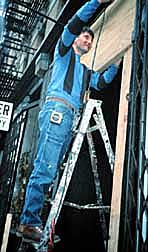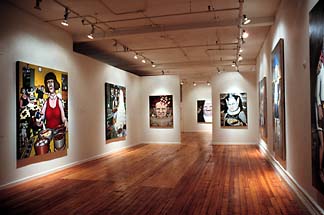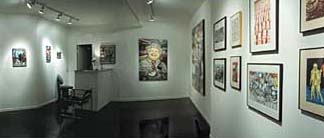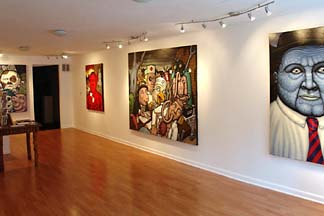|
The word Limner was first used in Medieval times to describe manuscript illuminators. In the following centuries it became a general descriptive term for an artist. The word gradually fell out of use and was revived to describe the itinerant artists of Colonial America. These self-taught, self-employed, independent artists worked in a graphic, figurative style and traveled from town to town in search of painting commissions. As these descriptives could also be applied to the galleries founder, the term Limner was adopted as the name of the gallery.
|
|
|
|
Limner Gallery was founded in 1987 by the artist Tim Slowinski at 216 East 10th Street in Manhattan's East Village. At that time, the Village was the center of the alternative art scene and Limner quickly became notorious for it's controversial and provocative exhibitions. Taking advantage of the 1980's art boom, the gallery operated successfully at this location. In 1990 the Limner Gallery moved to a Soho loft space at 598 Broadway. |
|
|
Limner's impressive 100 foot long gallery space was typical of Broadway galleries at that time. The area of Lower Broadway in Soho had been a manufacturing district, this loft space was formerly used for clothing manufacturing. In the early 1990s, the loft buildings on Broadway were converted to gallery space to house galleries relocating from the East Village and some new galleries. The Limner Gallery was across the street from the New Museum and Guggenheim Museum spaces that were located on Broadway at that time. |
|
|
In the mid 1990s the gallery also opened a storefront at 215 Mulberry Street. This storefront featured the work of Slowinski and operated in conjunction with the Limner on Broadway. This space, called Slowinski Gallery, operated at this location for four years. During the 1990s escalating Soho rents began forcing out the art galleries, replacing them with upscale boutiques and luxury loft apartments. Manhattan's downtown art scene began to move to Chelsea, which at that time was still a lower rent area of Manhattan. |
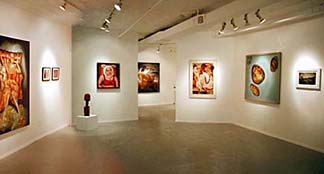 Limner at 870 Avenue of the Americas |
In 1998 Limner Gallery relocated to a loft space at 870 Avenue of the Americas, near Manhattan's expanding Chelsea art district. After the destruction of the Twin Towers on 9-11, New York City changed. The main postal sorting station was contaminated with anthrax and mailmen delivered mail with rubber gloves. The Army patrolled the street with M-16s. The art scene suffered a temporary decline as viewers and buyers sought entertainment and housing outside of Manhattan. This contributed to the relocation of the gallery in February 2004. |
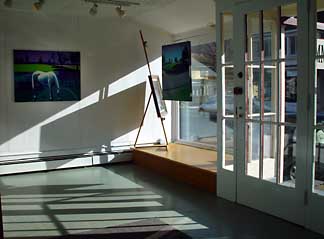 Limner at 59 Main St.in Phoenicia, NY |
From November of 2003 through July of 2006 Limner operated a storefront gallery in the Catskill Mountain resort town of Phoenicia, NY. Phoenicia was revitalized by the flight of city dwellers after 911 as New Yorkers sought refuge in the "safe haven" regions within a few hours drive of Manhattan. The Hudson Valley and Catskill economy were charged with a surge in second home purchases by New York City's wealthy elite and celebrities. |
|
|
The historic Hudson River port City of Hudson, NY is the current home of the Limner Gallery. Hudson is the fine art and antique center of the Hudson Valley and is a popular destination for art and antique collectors. Situated on the eastern bank of the Hudson River with a direct train link to Manhattan, Hudson is readily accessible to both city and country dwellers. It is situated centrally between the Catskill, Berkshire and Hudson Valley resort areas. |
| DIRECTIONS AND HOURS | |
